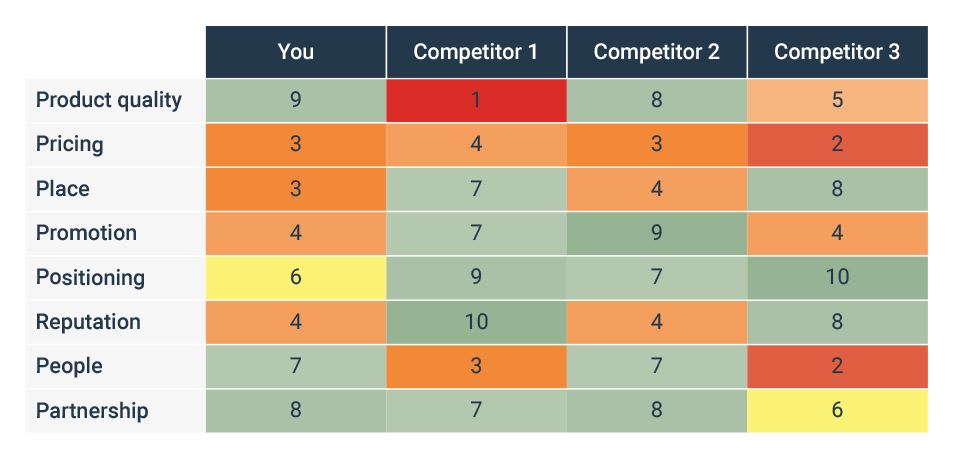Stay ahead of the competition! Learn how to conduct a thorough competitor analysis for a small business. Read our guide and improve your business success today.
Introduction Competitor Analysis For A Small Business
In today’s fast-paced business environment, it’s more important than ever for small businesses to stay ahead of the competition. One of the most effective ways to do this is by conducting a competitor analysis. Competitor analysis involves analyzing the strengths and weaknesses of your competitors to identify opportunities and threats for your business.
By conducting a thorough competitor analysis, you can gain valuable insights into your industry and the competition. You can learn about your competitors’ product or service offerings, pricing strategies, marketing tactics, target market, and more. Armed with this information, you can make more informed business decisions and take action to improve your own business’s success.
This blog post will provide a step-by-step guide for small businesses on how to conduct a thorough competitor analysis. We’ll cover the key elements you should analyze, such as product offerings, pricing, marketing strategies, and target market. We’ll also discuss how to gather information on these elements, such as website analysis and social media monitoring. Additionally, we’ll explain how to evaluate your own business in comparison to your competitors and identify your unique selling proposition (USP).
If you’re a small business owner looking to gain a competitive edge, then this post is for you. By the end of this guide, you’ll have a solid understanding of how to conduct a competitor analysis and use the information to improve your business’s success. So let’s get started!
What Is A Competitor Analysis

Competitor analysis is the process of analyzing the strengths and weaknesses of your competitors in your industry to identify opportunities and threats for your business.
It involves researching and evaluating your competitors’ products or services, pricing strategies, marketing tactics, target market, and more.
By conducting a thorough competitor analysis, businesses can gain valuable insights into their industry and competition, which can inform their business decisions and strategies for success.
Importance of conducting a competitor analysis for small businesses
Conducting a competitor analysis is crucial for small businesses for several reasons:
Identify Opportunities and Threats: A thorough competitor analysis can help small businesses identify potential opportunities and threats in their market.
It can reveal gaps in the market, new trends, and changes in consumer behavior, which can inform businesses’ decisions about product development, pricing strategies, and marketing campaigns.
Understand Your Competition: By analyzing your competitors, you can gain valuable insights into their strategies, strengths, and weaknesses. This knowledge can help small businesses understand what their competitors are doing well and where they may be falling short.
It can also help businesses differentiate themselves from the competition by highlighting their unique selling proposition.
Make Informed Business Decisions: With a comprehensive understanding of the market and competition, small businesses can make informed business decisions. This includes decisions about product development, pricing, marketing, and expansion.
Having a solid understanding of the competitive landscape can help businesses minimize risks and maximize opportunities for growth.
Improve Business Success: By analyzing competitors, small businesses can identify opportunities to improve their product or service offerings, pricing strategies, marketing campaigns, and more. This can help businesses improve their competitive edge, attract and retain customers, and ultimately increase their chances of success in a crowded market.
Overall, conducting a competitor analysis is essential for small businesses looking to stay ahead of the competition and achieve long-term success.[1]
How to do a competitive analysis on a small business
Here are the 5 main steps to conducting a successful competitive analysis for small businesses.

- Identify Your Competitors: Start by identifying your direct and indirect competitors in the market. You can do this by conducting research online, reviewing industry reports, and talking to your customers. Make a list of your competitors, including their name, product/service offerings, target market, and unique selling proposition.
- Analyze Your Competitors: Once you have identified your competitors, it’s time to analyze their business strategies. Look at their product/service offerings, pricing strategies, marketing tactics, target market, strengths, and weaknesses. You can gather information by visiting their website, analyzing their social media presence, monitoring customer reviews, and reading industry reports.
- Evaluate Your Own Business: After analyzing your competitors, evaluate your own business in comparison to your competitors. Compare your product/service offerings, pricing, marketing strategies, target market, and strengths/weaknesses against your competitors. This comparison will help you identify your unique selling proposition (USP), which is what makes your business stand out from the competition.
- Develop an Action Plan: Based on the information you’ve gathered, develop an action plan to improve your business. Identify areas where you can adjust pricing, improve your product/service offerings, enhance your marketing strategies, and develop a unique selling proposition. Make a list of actionable steps and prioritize them based on their potential impact and feasibility.
- Monitor and Update: Finally, it’s important to continuously monitor and update your competitive analysis. Stay up-to-date on industry trends, changes in consumer behavior, and new competitors in the market. Regularly review and adjust your action plan to stay ahead of the competition and achieve long-term success.
Identifying Your Competitors

Follow these steps, identify your competitors, and gain valuable insights into their business strategies. This knowledge can help you stay ahead of the competition and make informed decisions to improve your business’s success.
- Google Search: Use search engines such as Google to search for companies in your industry or niche. Try searching for keywords related to your business to find competitors who are ranking for these terms.
- Industry Reports: Look for industry reports or market research that identify key players in your industry. These reports can provide insights into your competition and their business strategies.
- Social Media: Check out your competitors’ social media profiles to see how they engage with customers and promote their products or services. Follow their pages and monitor their activity to stay up-to-date on their latest news and updates.
- Customer Surveys: Survey your customers to find out which other companies they are considering or have used in the past. This can help you identify your direct and indirect competitors and understand how your customers view your competition.
- Online Directories: Check online directories such as Yelp, Yellow Pages, and Google My Business to find local competitors in your industry. These directories often provide a list of businesses in your area, making it easy to identify your competitors.
Analyze your competitors
The next step is to analyze the competition
When conducting a competitor analysis, there are several key elements to analyze. Here’s a more detailed explanation of each of these elements:
Product/Service Offerings: Start by analyzing your competitors’ product or service offerings. Look at the features, quality, and pricing of their products or services. This will help you understand what your competitors are offering and how your own products or services compare.
Pricing: Pricing is a critical factor in many industries. Analyze your competitors’ pricing strategies, including any discounts or promotions they offer. This will help you understand how your pricing compares and identify opportunities to adjust your pricing to better compete.
Marketing Strategies: Analyze your competitors’ marketing strategies, including their branding, messaging, and advertising channels. Look at how they are positioning themselves in the market and how they are engaging with customers. This will help you understand what marketing tactics are working for your competitors and identify opportunities to improve your own marketing efforts.
Target Market: Analyze your competitors’ target market. Look at their customer demographics, psychographics, and behaviors. This will help you understand who your competitors are targeting and how you can differentiate your own business by targeting a different audience.
Strengths and Weaknesses: Finally, analyze your competitors’ strengths and weaknesses. Look at what they are doing well and where they may be falling short. This will help you understand where you can differentiate your own business and identify areas for improvement.
Create a template for conducting competitor analysis for a small business
(VIDEO SHOWING HOW)
Evaluate your own business

Once you have analyzed your competitors, it’s time to evaluate your own business in comparison to theirs. This means taking a close look at your product or service offerings, pricing strategies, marketing tactics, target market, and strengths/weaknesses.
Here are some steps to follow when evaluating your business:
- List your products or services and compare them to your competitors’ offerings. How do they compare in terms of quality, features, and pricing?
- Evaluate your pricing strategies and compare them to your competitors. Are you offering a competitive price, or are you priced too high or too low?
- Analyze your marketing strategies and tactics and compare them to your competitors. Are you reaching the same target market? How are your competitors differentiating themselves in the market?
- Identify your strengths and weaknesses and compare them to your competitors. What advantages do you have over your competitors, and where are they outperforming you?
Use the information to improve your business
How to use the information gathered from the competitor analysis to improve your business:
Once you have gathered information on your competitors and evaluated your own business, it’s time to use that information to improve your business.
Here are some steps to follow:

Identify areas where you can differentiate your business from your competitors. For example, you may have identified that your competitors offer similar products or services, but they are lacking in customer service. You can use this information to improve your own customer service to differentiate yourself in the market.
Identify areas where you can improve your product or service offerings. For example, you may have identified that your competitors offer a wider range of products or services than you do. You can use this information to expand your offerings and compete more effectively.
Adjust your pricing strategy if necessary. For example, if you identified that your competitors offer a lower price point, you may need to adjust your pricing strategy to remain competitive.
Enhance your marketing strategies.
Use the information you gathered on your competitors’ marketing strategies to improve your own. This may involve revising your messaging or targeting a different audience.
Develop a unique selling proposition (USP) based on what you learned from the analysis. Use this to differentiate yourself from your competitors and communicate your unique value proposition to customers.
Examples of actions to take based on the analysis:
Based on the information gathered from your competitor analysis, here are some examples of actions you can take:
- Adjust your pricing strategy to remain competitive.
- Expand your product or service offerings to differentiate yourself in the market.
- Enhance your customer service to differentiate yourself from competitors.
- Develop a unique value proposition that sets you apart from competitors.
- Use the insights gathered on your competitors’ marketing strategies to improve your own marketing efforts.
- Adjust your target market to differentiate yourself from competitors.
- Improve your online presence to compete more effectively in the digital marketplace.
By taking these actions, you can use the information gathered from the competitor analysis to improve your business success and stay ahead of the competition.
If you need any help with your marketing and doing a Competitor Analysis For your Small Business contact Milfordctmarketing.com or call 860-566-8987


